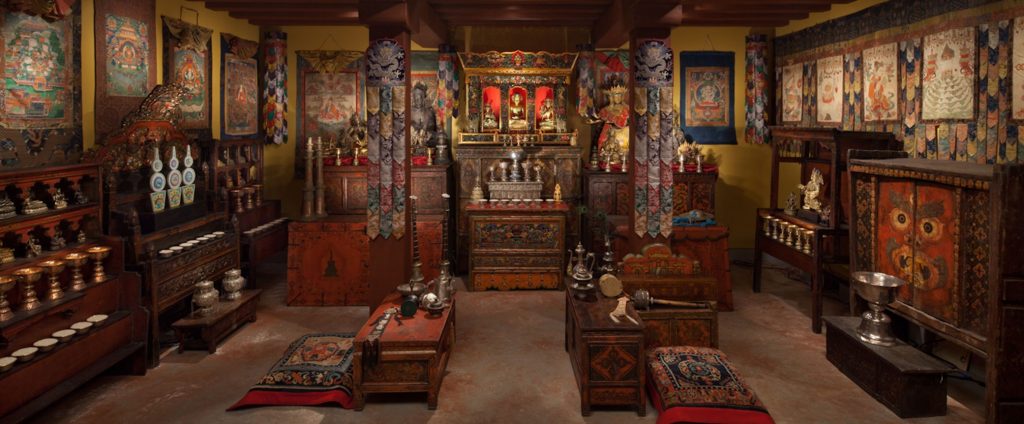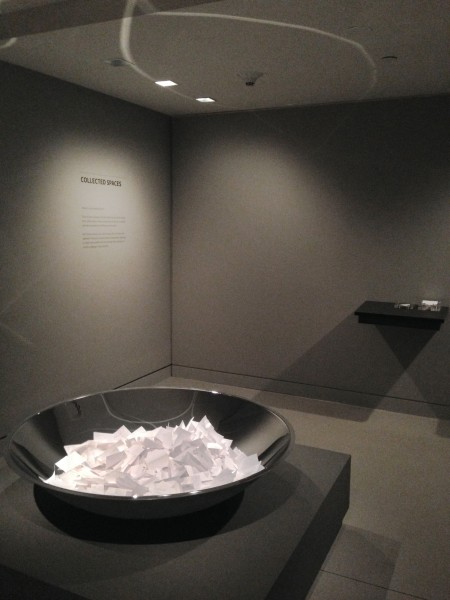Focusing on cross-cultural connections, the Rubin Museum of Art showcases art of Himalayas and neighboring regions including India. On September 8, 2016, our Museum Education class visited the museum. We had the pleasure of meeting Nicole Leist, Manager of Academic Programs, who gave us a tour of the museum. The experience with Nicole was very enjoyable and productive. The museum has 6 floors; the second-floor gallery displays objects from the permanent collection, introducing audiences to Himalayan art. As Nicole explained, the intention behind the second-floor gallery is to provide audiences with the background knowledge and the language to learn about art in this region. The third floor is dedicated to more specific forms of art, and the fourth floor is an interactive space, where many of the museum programs are held. During the tour, there are two works that are very memorable to me: the Vajrayogini statue and a recreation of Tibetan shrine, which were also two main works explained by Nicole.
Nicole began the tour by asking about our majors and area of focuses as artists and art historians. I very much enjoyed the educational strategy employed by Nicole when she showed us a Tibetan Buddhist, the sculpture of the deity Vajrayogini, who represents feminine energies (http://rubinmuseum.org/blog/march-womens-history-month-art).
To unpack the complex and the multi-layered symbols inherent in Buddhist culture and the sculpture, Nicole first encouraged us to engage with artworks through direct and visceral experiences. Giving a general idea about a piece first, she would then ask us to describe the artwork, which created a conversation between her as an educator and us as the audience. As for the Vajrayogini deity sculpture, after telling us that the artwork would challenge some of the western perspectives on Buddhist deities, Nicole asked us to point out the “unusual” components in the sculpture. She then began to contextualize the piece in a witty and expressive way by using straightforward, yet vivid language. For example, she referred to the deity as a “sexy and scary teacher” and a “tough lady” when discussing the relationship between the role and the energy of this deity. Nicole employed a sense of humor, she also made interesting and lucid analogs when experiencing complex and confusing topics. An example was when she raised the question “why does a Wrathful deity seem to be horrifying?” She described them as “angry” deities before comparing the deity with a super-powered mother, who would show an intense yet fierce energy when pushing away a truck in order to save her child. Through the educator’s humorous and vivid storytelling, I was able to comprehend her teaching immediately and joyfully, which also left a strong impression on me about the work thus fulfills her pedagogical goal as an educator.
As a culturally specific institution, the Rubin’s educators such as Nicole, who is truly interested in the artworks shown at the museum, and is happy to engage with audiences, helped me gaining knowledge about the region, religion and the art. At the same time, some of the institution’s interactive exhibitions and guided tours also provide audiences with multi-sensory experiences. For example, there is a recreation of Tibetan shrine inside of the museum.
Audiences are able to engage with the space through visual, auditory, and even olfactory experiences, which as if leading them into the actual environment and the culture. This kind of interactive dynamic is evident in The Looking Rubin Guide, a brochure with beautiful drawings showing Figures, Postures, Gestures and Implements in Buddhist and Hindu art. With the guide, audiences are able to identify and learn about he fundamental symbols viewing the artworks. The information and the guide are also displayed on wall panels adjacent to specific artworks to illustrate some important symbols.
Upon viewing the illustration, I found myself beginning to mimic the hand gestures. The brochure invited me to recognize common symbols and important figures in Buddhist art. Another interactive element at the Rubin is the installation “collected Spaces,” which is a large container with audiences’ notes created when they make a wish.
The wall text for the “space” opens up with a question “where is your sacred space?” As appealing and welcoming as the wall text is, the space itself is designed tranquilly and intimately, encouraging the audiences to contribute their notes, but more importantly to share their personal experiences with the institution. Thus the audiences no longer receive an isolated and merely didactic experience, but also shared stories among other audiences, as well as the connection with the museum.
I enjoyed my experience at the Rubin Museum, with educator Nicole Leist. I expanded my knowledge of the role as an educator and strategies that could potentially maximize audiences’ comprehension in the context of a culturally specific museum. As an audience, I would like to visit the museum again and participate in more of the educational programs and public programming at the Rubin Museum.









